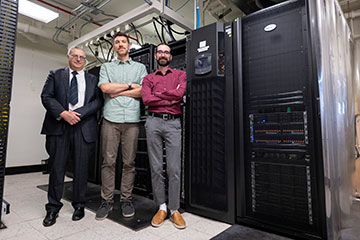
Alexander Efros (left), John Lyons (center) and, Michael Swift at the Naval Research Laboratory in Washington, DC, worked with colleagues in the United States and Switzerland to devise a new way of identifying compounds that could be made into bright nanocrystals. [Image: US Navy photo by Sarah Peterson]
Scientists in the United States and Europe have developed a new method for identifying compounds that could be used to make bright semiconductor nanocrystals based on the inversion of low-lying exciton energy levels (ACS Nano, doi: 10.1021/acsnano.4c02905). They identified four such materials, and they say that once confirmed by experimentalists, these nanocrystals could be used to make new types of light-emitting diodes and lasers and as quantum dots.
A double-edged sword
Semiconductor nanocrystals are already used as emitters in numerous optoelectronic devices. Like any semiconductor, they generate light in the form of photons when electrons combine with holes. But this process is enhanced if electrons first bind with holes to create what are known as excitons. The compactness of nanocrystals boosts emission further by confining excitons to very small spaces.
That compact nature, however, is a double-edged sword. The interaction between electrons and holes splits excitons so that they exist over a number of distinct subenergy levels, but if the excitons are confined to a smaller space, the gap between levels increases. This isolates the lowest level, where recombination is forbidden, slowing down emission. Bulk semiconductors, in contrast, have more closely spaced sublevels, and the gap between them can be crossed by thermal noise.
Brightening the ground state
Researchers have looked at a number of ways to overcome this problem. These include identifying either materials or mechanisms―such as applying external magnetic fields―that can brighten the "dark" ground state. Alternatively, some have sought to reverse the order of states so that the crucial ground state becomes bright. This possibility has been given renewed impetus in recent years, after it was found that nanocrystals made from cesium–lead–halide perovskites can be exceptionally bright. This discovery prompted theorists to propose what is known as the Rashba effect to explain the circumstances under which inversion might occur.
In the latest work, Michael Swift and coworkers at the Naval Research Laboratory in Washington, DC, together with colleagues in Colorado and Switzerland, suggest a way to systematically search for compounds capable of inversion. Their method involves extracting promising initial candidates from two open-source databases, the Materials Project and Aflowlib, which together list over 500,000 inorganic compounds.
Their method involves extracting promising initial candidates from two open-source databases, the Materials Project and Aflowlib, which together list over 500,000 inorganic compounds.
As they point out, these databases are missing a piece of information crucial for the Rashba effect—the degree of spin-orbit coupling within a given material. So they instead identify promising candidates by relying on a number of proxy criteria, including whether or not a material is an insulator or semiconductor, and whether that material contains heavy elements from the p-block of the periodic table (which have a number of desirable characteristics, including strong spin-orbit coupling).
Applying these criteria, they ended up with 173 promising compounds. They then worked out from first principles whether or not each of these materials should exhibit the Rashba effect. They used density functional theory and several other theoretical frameworks to check the results. Finally, they inserted a number of material parameters, including bandgap energy and exciton Bohr radius, into specialized models to work out the fine-structure energy levels for some of the remaining 28 candidate compounds.
The end result was four compounds that ought to feature bright excitons in their ground states. Two of these were previously unidentified bismuth tellurohalides―one containing chlorine and the other iodine. The third was gallium telluride, which emits in the infrared, and the fourth was potassium iodate, which is an ultraviolet emitter. The researchers also looked at a third bismuth tellurohalide, this time containing bromine, but found that, unlike the other four compounds, its lowest-energy bright and dark states did not overlap.
Experimental confirmation
Having succeeded in identifying these candidate nanocrystals, Swift and colleagues say that the next step is to confirm the results experimentally. Colleagues at the Naval Research Laboratory are currently growing three of the four identified materials, and they hope that scientists in other labs will follow suit.
They point out that fabricating previously unknown nanocrystals can be tricky, given the need to carefully control the crystals' size and shape as well as avoid any defects that would impair emission efficiency. But they reckon that advances in nanoscale fabrication made in recent years should help overcome these hurdles. Once fabricated, the team says that experiments involving variations in time, temperature and magnetic field should enable the fine structure levels to be probed, thereby confirming the predicted level inversion or ruling it out.
Swift and colleagues add that there could be many other promising compounds beyond the four that they have identified. They say that they used conservative criteria to establish their initial list of possible bright-exciton materials, meaning that some candidates may have been missed. The group also points out that open-source databases are continually expanding, which will enlarge the pool of starting materials over time.
The researchers conclude: “The success of our search procedure, despite the lack of spin−orbit-coupling information in the databases, illustrates the power of combining physical understanding with high-throughput techniques.”
